Modest Fashion: A Dissertation on Trends, Religion, and Design
VerifiedAdded on 2021/02/21
|6
|2046
|240
Essay
AI Summary
This essay delves into the multifaceted world of modest fashion, examining its definition, historical context, and contemporary relevance. It explores the evolution of modest dressing, tracing its roots in religious and cultural practices and its transformation into a global trend. The essay analyzes the perspectives of contemporary designers and mainstream fashion, highlighting the influence of social media and the emergence of a multi-billion-dollar market. It showcases the impact of young Muslim women, like Halima Aden, in shaping the modest fashion landscape and their role in bridging faith and modernity. The essay also considers the influence of brands like Maison Margiela and Yohji Yamamoto. It also addresses the challenges faced by Muslim women in the Western world and their empowerment through fashion, concluding with the author's personal interest in modest aesthetics and their design aspirations.
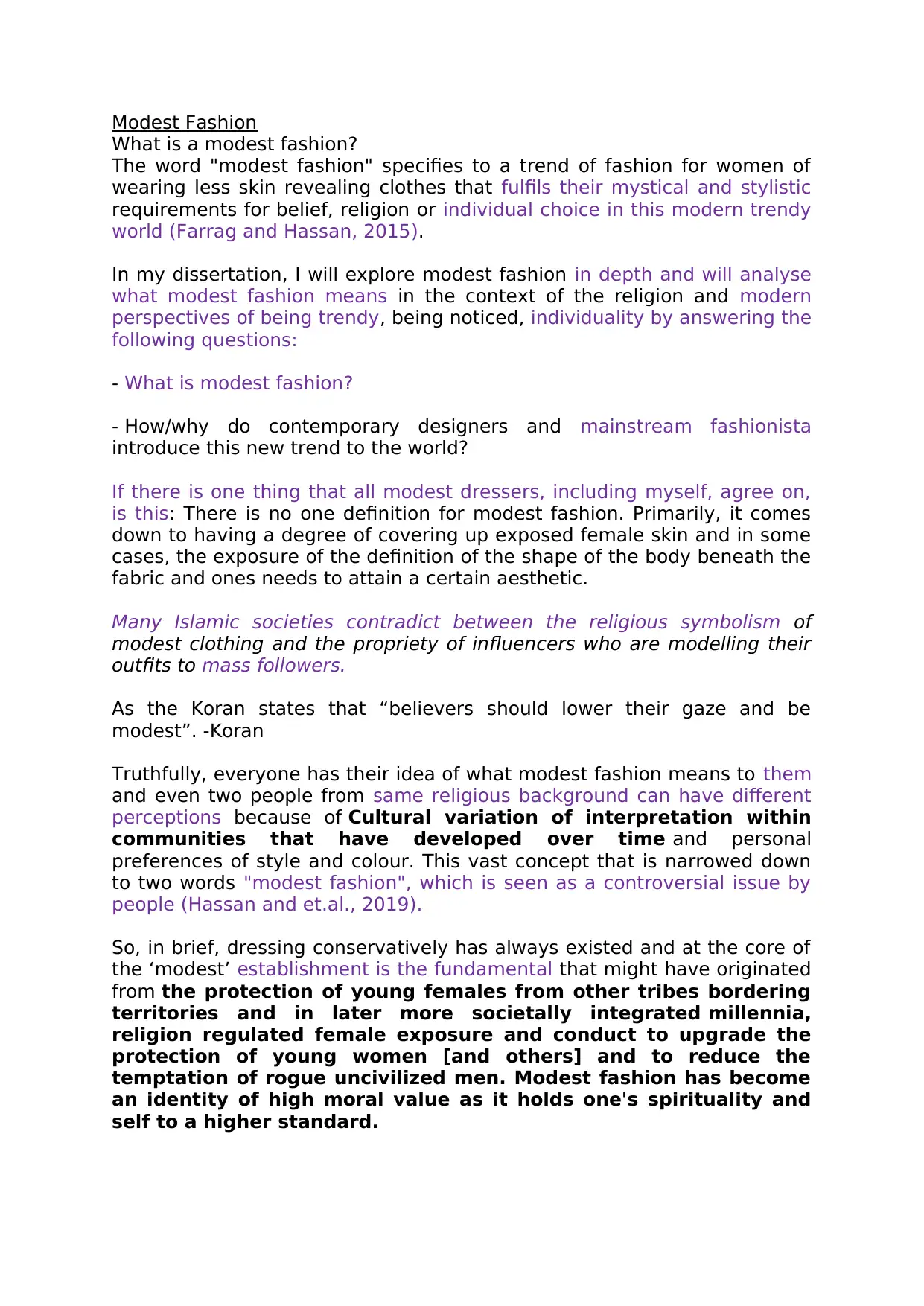
Modest Fashion
What is a modest fashion?
The word "modest fashion" specifies to a trend of fashion for women of
wearing less skin revealing clothes that fulfils their mystical and stylistic
requirements for belief, religion or individual choice in this modern trendy
world (Farrag and Hassan, 2015).
In my dissertation, I will explore modest fashion in depth and will analyse
what modest fashion means in the context of the religion and modern
perspectives of being trendy, being noticed, individuality by answering the
following questions:
- What is modest fashion?
- How/why do contemporary designers and mainstream fashionista
introduce this new trend to the world?
If there is one thing that all modest dressers, including myself, agree on,
is this: There is no one definition for modest fashion. Primarily, it comes
down to having a degree of covering up exposed female skin and in some
cases, the exposure of the definition of the shape of the body beneath the
fabric and ones needs to attain a certain aesthetic.
Many Islamic societies contradict between the religious symbolism of
modest clothing and the propriety of influencers who are modelling their
outfits to mass followers.
As the Koran states that “believers should lower their gaze and be
modest”. -Koran
Truthfully, everyone has their idea of what modest fashion means to them
and even two people from same religious background can have different
perceptions because of Cultural variation of interpretation within
communities that have developed over time and personal
preferences of style and colour. This vast concept that is narrowed down
to two words "modest fashion", which is seen as a controversial issue by
people (Hassan and et.al., 2019).
So, in brief, dressing conservatively has always existed and at the core of
the ‘modest’ establishment is the fundamental that might have originated
from the protection of young females from other tribes bordering
territories and in later more societally integrated millennia,
religion regulated female exposure and conduct to upgrade the
protection of young women [and others] and to reduce the
temptation of rogue uncivilized men. Modest fashion has become
an identity of high moral value as it holds one's spirituality and
self to a higher standard.
What is a modest fashion?
The word "modest fashion" specifies to a trend of fashion for women of
wearing less skin revealing clothes that fulfils their mystical and stylistic
requirements for belief, religion or individual choice in this modern trendy
world (Farrag and Hassan, 2015).
In my dissertation, I will explore modest fashion in depth and will analyse
what modest fashion means in the context of the religion and modern
perspectives of being trendy, being noticed, individuality by answering the
following questions:
- What is modest fashion?
- How/why do contemporary designers and mainstream fashionista
introduce this new trend to the world?
If there is one thing that all modest dressers, including myself, agree on,
is this: There is no one definition for modest fashion. Primarily, it comes
down to having a degree of covering up exposed female skin and in some
cases, the exposure of the definition of the shape of the body beneath the
fabric and ones needs to attain a certain aesthetic.
Many Islamic societies contradict between the religious symbolism of
modest clothing and the propriety of influencers who are modelling their
outfits to mass followers.
As the Koran states that “believers should lower their gaze and be
modest”. -Koran
Truthfully, everyone has their idea of what modest fashion means to them
and even two people from same religious background can have different
perceptions because of Cultural variation of interpretation within
communities that have developed over time and personal
preferences of style and colour. This vast concept that is narrowed down
to two words "modest fashion", which is seen as a controversial issue by
people (Hassan and et.al., 2019).
So, in brief, dressing conservatively has always existed and at the core of
the ‘modest’ establishment is the fundamental that might have originated
from the protection of young females from other tribes bordering
territories and in later more societally integrated millennia,
religion regulated female exposure and conduct to upgrade the
protection of young women [and others] and to reduce the
temptation of rogue uncivilized men. Modest fashion has become
an identity of high moral value as it holds one's spirituality and
self to a higher standard.
Paraphrase This Document
Need a fresh take? Get an instant paraphrase of this document with our AI Paraphraser
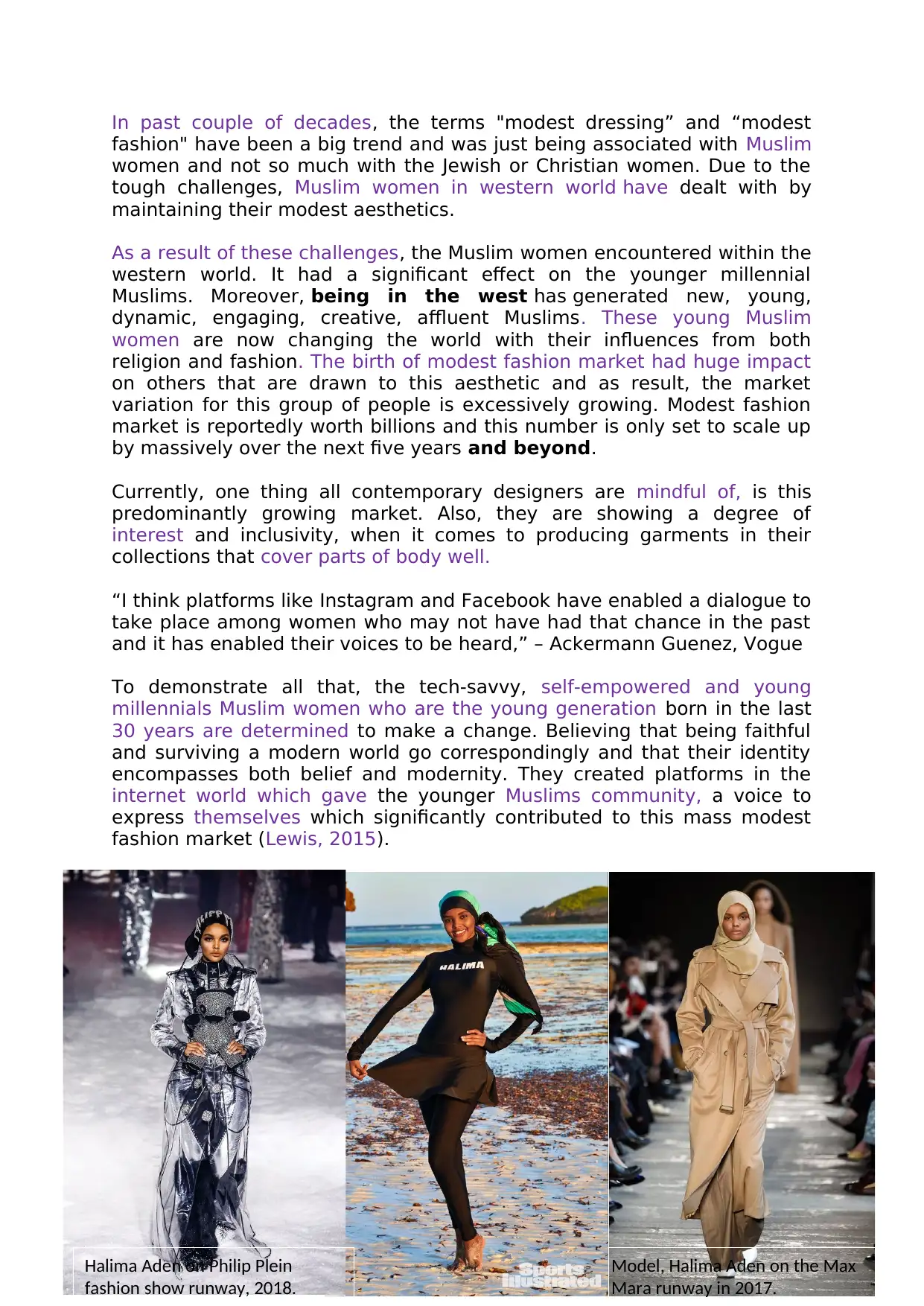
Model, Halima Aden on the Max
Mara runway in 2017.
Halima Aden on Philip Plein
fashion show runway, 2018.
In past couple of decades, the terms "modest dressing” and “modest
fashion" have been a big trend and was just being associated with Muslim
women and not so much with the Jewish or Christian women. Due to the
tough challenges, Muslim women in western world have dealt with by
maintaining their modest aesthetics.
As a result of these challenges, the Muslim women encountered within the
western world. It had a significant effect on the younger millennial
Muslims. Moreover, being in the west has generated new, young,
dynamic, engaging, creative, affluent Muslims. These young Muslim
women are now changing the world with their influences from both
religion and fashion. The birth of modest fashion market had huge impact
on others that are drawn to this aesthetic and as result, the market
variation for this group of people is excessively growing. Modest fashion
market is reportedly worth billions and this number is only set to scale up
by massively over the next five years and beyond.
Currently, one thing all contemporary designers are mindful of, is this
predominantly growing market. Also, they are showing a degree of
interest and inclusivity, when it comes to producing garments in their
collections that cover parts of body well.
“I think platforms like Instagram and Facebook have enabled a dialogue to
take place among women who may not have had that chance in the past
and it has enabled their voices to be heard,” – Ackermann Guenez, Vogue
To demonstrate all that, the tech-savvy, self-empowered and young
millennials Muslim women who are the young generation born in the last
30 years are determined to make a change. Believing that being faithful
and surviving a modern world go correspondingly and that their identity
encompasses both belief and modernity. They created platforms in the
internet world which gave the younger Muslims community, a voice to
express themselves which significantly contributed to this mass modest
fashion market (Lewis, 2015).
Mara runway in 2017.
Halima Aden on Philip Plein
fashion show runway, 2018.
In past couple of decades, the terms "modest dressing” and “modest
fashion" have been a big trend and was just being associated with Muslim
women and not so much with the Jewish or Christian women. Due to the
tough challenges, Muslim women in western world have dealt with by
maintaining their modest aesthetics.
As a result of these challenges, the Muslim women encountered within the
western world. It had a significant effect on the younger millennial
Muslims. Moreover, being in the west has generated new, young,
dynamic, engaging, creative, affluent Muslims. These young Muslim
women are now changing the world with their influences from both
religion and fashion. The birth of modest fashion market had huge impact
on others that are drawn to this aesthetic and as result, the market
variation for this group of people is excessively growing. Modest fashion
market is reportedly worth billions and this number is only set to scale up
by massively over the next five years and beyond.
Currently, one thing all contemporary designers are mindful of, is this
predominantly growing market. Also, they are showing a degree of
interest and inclusivity, when it comes to producing garments in their
collections that cover parts of body well.
“I think platforms like Instagram and Facebook have enabled a dialogue to
take place among women who may not have had that chance in the past
and it has enabled their voices to be heard,” – Ackermann Guenez, Vogue
To demonstrate all that, the tech-savvy, self-empowered and young
millennials Muslim women who are the young generation born in the last
30 years are determined to make a change. Believing that being faithful
and surviving a modern world go correspondingly and that their identity
encompasses both belief and modernity. They created platforms in the
internet world which gave the younger Muslims community, a voice to
express themselves which significantly contributed to this mass modest
fashion market (Lewis, 2015).
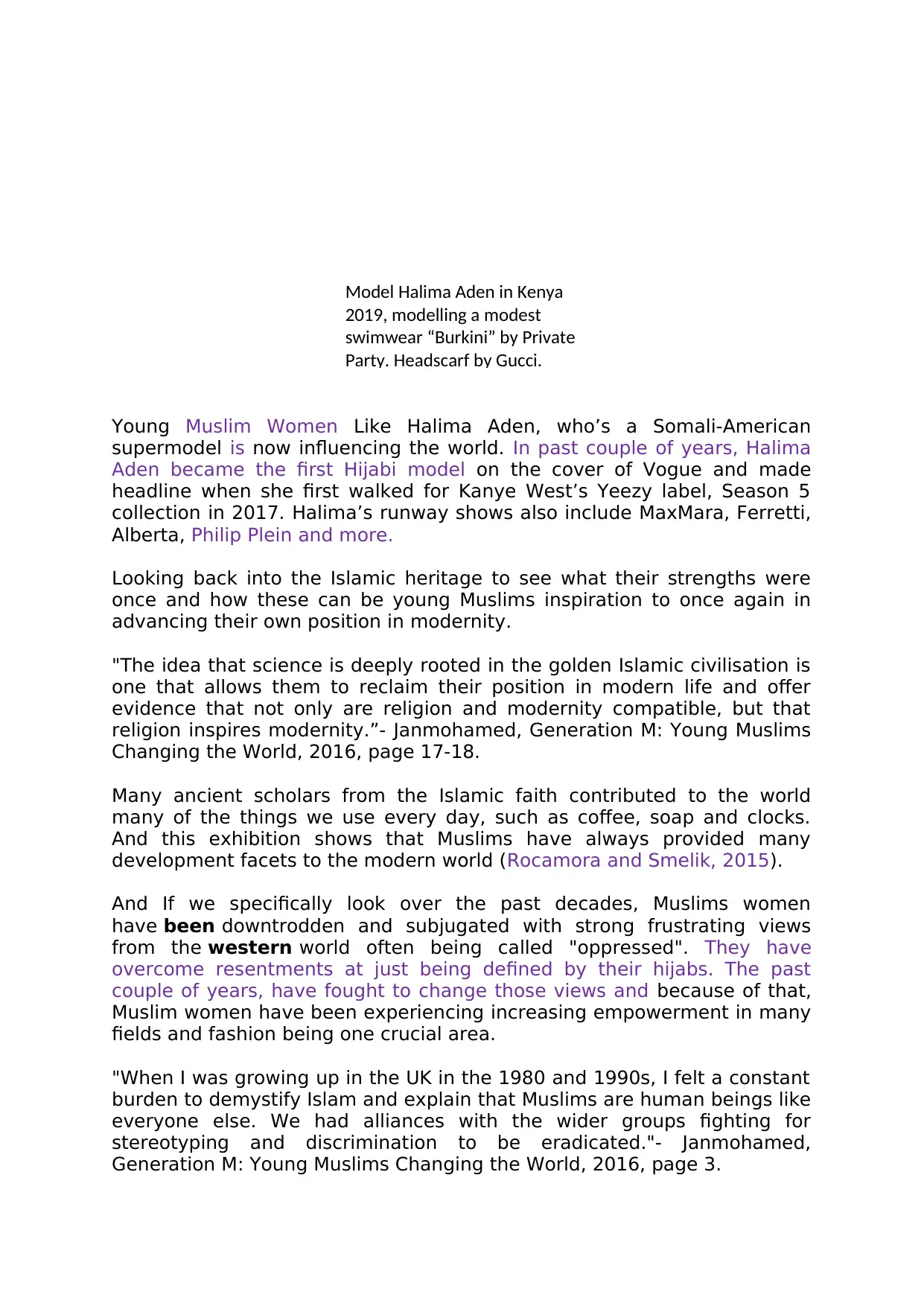
Model Halima Aden in Kenya
2019, modelling a modest
swimwear “Burkini” by Private
Party. Headscarf by Gucci.
Young Muslim Women Like Halima Aden, who’s a Somali-American
supermodel is now influencing the world. In past couple of years, Halima
Aden became the first Hijabi model on the cover of Vogue and made
headline when she first walked for Kanye West’s Yeezy label, Season 5
collection in 2017. Halima’s runway shows also include MaxMara, Ferretti,
Alberta, Philip Plein and more.
Looking back into the Islamic heritage to see what their strengths were
once and how these can be young Muslims inspiration to once again in
advancing their own position in modernity.
"The idea that science is deeply rooted in the golden Islamic civilisation is
one that allows them to reclaim their position in modern life and offer
evidence that not only are religion and modernity compatible, but that
religion inspires modernity.”- Janmohamed, Generation M: Young Muslims
Changing the World, 2016, page 17-18.
Many ancient scholars from the Islamic faith contributed to the world
many of the things we use every day, such as coffee, soap and clocks.
And this exhibition shows that Muslims have always provided many
development facets to the modern world (Rocamora and Smelik, 2015).
And If we specifically look over the past decades, Muslims women
have been downtrodden and subjugated with strong frustrating views
from the western world often being called "oppressed". They have
overcome resentments at just being defined by their hijabs. The past
couple of years, have fought to change those views and because of that,
Muslim women have been experiencing increasing empowerment in many
fields and fashion being one crucial area.
"When I was growing up in the UK in the 1980 and 1990s, I felt a constant
burden to demystify Islam and explain that Muslims are human beings like
everyone else. We had alliances with the wider groups fighting for
stereotyping and discrimination to be eradicated."- Janmohamed,
Generation M: Young Muslims Changing the World, 2016, page 3.
2019, modelling a modest
swimwear “Burkini” by Private
Party. Headscarf by Gucci.
Young Muslim Women Like Halima Aden, who’s a Somali-American
supermodel is now influencing the world. In past couple of years, Halima
Aden became the first Hijabi model on the cover of Vogue and made
headline when she first walked for Kanye West’s Yeezy label, Season 5
collection in 2017. Halima’s runway shows also include MaxMara, Ferretti,
Alberta, Philip Plein and more.
Looking back into the Islamic heritage to see what their strengths were
once and how these can be young Muslims inspiration to once again in
advancing their own position in modernity.
"The idea that science is deeply rooted in the golden Islamic civilisation is
one that allows them to reclaim their position in modern life and offer
evidence that not only are religion and modernity compatible, but that
religion inspires modernity.”- Janmohamed, Generation M: Young Muslims
Changing the World, 2016, page 17-18.
Many ancient scholars from the Islamic faith contributed to the world
many of the things we use every day, such as coffee, soap and clocks.
And this exhibition shows that Muslims have always provided many
development facets to the modern world (Rocamora and Smelik, 2015).
And If we specifically look over the past decades, Muslims women
have been downtrodden and subjugated with strong frustrating views
from the western world often being called "oppressed". They have
overcome resentments at just being defined by their hijabs. The past
couple of years, have fought to change those views and because of that,
Muslim women have been experiencing increasing empowerment in many
fields and fashion being one crucial area.
"When I was growing up in the UK in the 1980 and 1990s, I felt a constant
burden to demystify Islam and explain that Muslims are human beings like
everyone else. We had alliances with the wider groups fighting for
stereotyping and discrimination to be eradicated."- Janmohamed,
Generation M: Young Muslims Changing the World, 2016, page 3.
⊘ This is a preview!⊘
Do you want full access?
Subscribe today to unlock all pages.

Trusted by 1+ million students worldwide
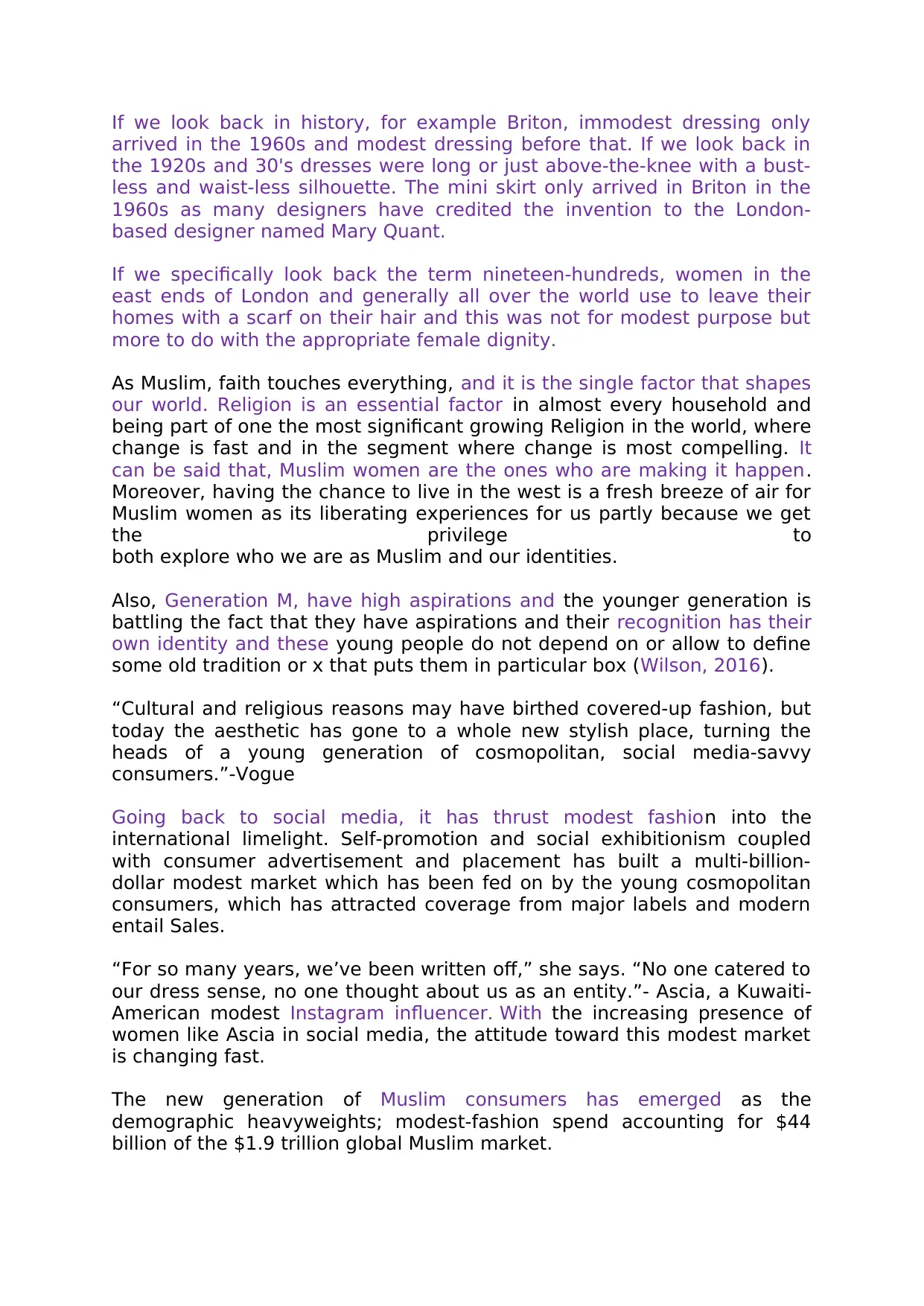
If we look back in history, for example Briton, immodest dressing only
arrived in the 1960s and modest dressing before that. If we look back in
the 1920s and 30's dresses were long or just above-the-knee with a bust-
less and waist-less silhouette. The mini skirt only arrived in Briton in the
1960s as many designers have credited the invention to the London-
based designer named Mary Quant.
If we specifically look back the term nineteen-hundreds, women in the
east ends of London and generally all over the world use to leave their
homes with a scarf on their hair and this was not for modest purpose but
more to do with the appropriate female dignity.
As Muslim, faith touches everything, and it is the single factor that shapes
our world. Religion is an essential factor in almost every household and
being part of one the most significant growing Religion in the world, where
change is fast and in the segment where change is most compelling. It
can be said that, Muslim women are the ones who are making it happen.
Moreover, having the chance to live in the west is a fresh breeze of air for
Muslim women as its liberating experiences for us partly because we get
the privilege to
both explore who we are as Muslim and our identities.
Also, Generation M, have high aspirations and the younger generation is
battling the fact that they have aspirations and their recognition has their
own identity and these young people do not depend on or allow to define
some old tradition or x that puts them in particular box (Wilson, 2016).
“Cultural and religious reasons may have birthed covered-up fashion, but
today the aesthetic has gone to a whole new stylish place, turning the
heads of a young generation of cosmopolitan, social media-savvy
consumers.”-Vogue
Going back to social media, it has thrust modest fashion into the
international limelight. Self-promotion and social exhibitionism coupled
with consumer advertisement and placement has built a multi-billion-
dollar modest market which has been fed on by the young cosmopolitan
consumers, which has attracted coverage from major labels and modern
entail Sales.
“For so many years, we’ve been written off,” she says. “No one catered to
our dress sense, no one thought about us as an entity.”- Ascia, a Kuwaiti-
American modest Instagram influencer. With the increasing presence of
women like Ascia in social media, the attitude toward this modest market
is changing fast.
The new generation of Muslim consumers has emerged as the
demographic heavyweights; modest-fashion spend accounting for $44
billion of the $1.9 trillion global Muslim market.
arrived in the 1960s and modest dressing before that. If we look back in
the 1920s and 30's dresses were long or just above-the-knee with a bust-
less and waist-less silhouette. The mini skirt only arrived in Briton in the
1960s as many designers have credited the invention to the London-
based designer named Mary Quant.
If we specifically look back the term nineteen-hundreds, women in the
east ends of London and generally all over the world use to leave their
homes with a scarf on their hair and this was not for modest purpose but
more to do with the appropriate female dignity.
As Muslim, faith touches everything, and it is the single factor that shapes
our world. Religion is an essential factor in almost every household and
being part of one the most significant growing Religion in the world, where
change is fast and in the segment where change is most compelling. It
can be said that, Muslim women are the ones who are making it happen.
Moreover, having the chance to live in the west is a fresh breeze of air for
Muslim women as its liberating experiences for us partly because we get
the privilege to
both explore who we are as Muslim and our identities.
Also, Generation M, have high aspirations and the younger generation is
battling the fact that they have aspirations and their recognition has their
own identity and these young people do not depend on or allow to define
some old tradition or x that puts them in particular box (Wilson, 2016).
“Cultural and religious reasons may have birthed covered-up fashion, but
today the aesthetic has gone to a whole new stylish place, turning the
heads of a young generation of cosmopolitan, social media-savvy
consumers.”-Vogue
Going back to social media, it has thrust modest fashion into the
international limelight. Self-promotion and social exhibitionism coupled
with consumer advertisement and placement has built a multi-billion-
dollar modest market which has been fed on by the young cosmopolitan
consumers, which has attracted coverage from major labels and modern
entail Sales.
“For so many years, we’ve been written off,” she says. “No one catered to
our dress sense, no one thought about us as an entity.”- Ascia, a Kuwaiti-
American modest Instagram influencer. With the increasing presence of
women like Ascia in social media, the attitude toward this modest market
is changing fast.
The new generation of Muslim consumers has emerged as the
demographic heavyweights; modest-fashion spend accounting for $44
billion of the $1.9 trillion global Muslim market.
Paraphrase This Document
Need a fresh take? Get an instant paraphrase of this document with our AI Paraphraser
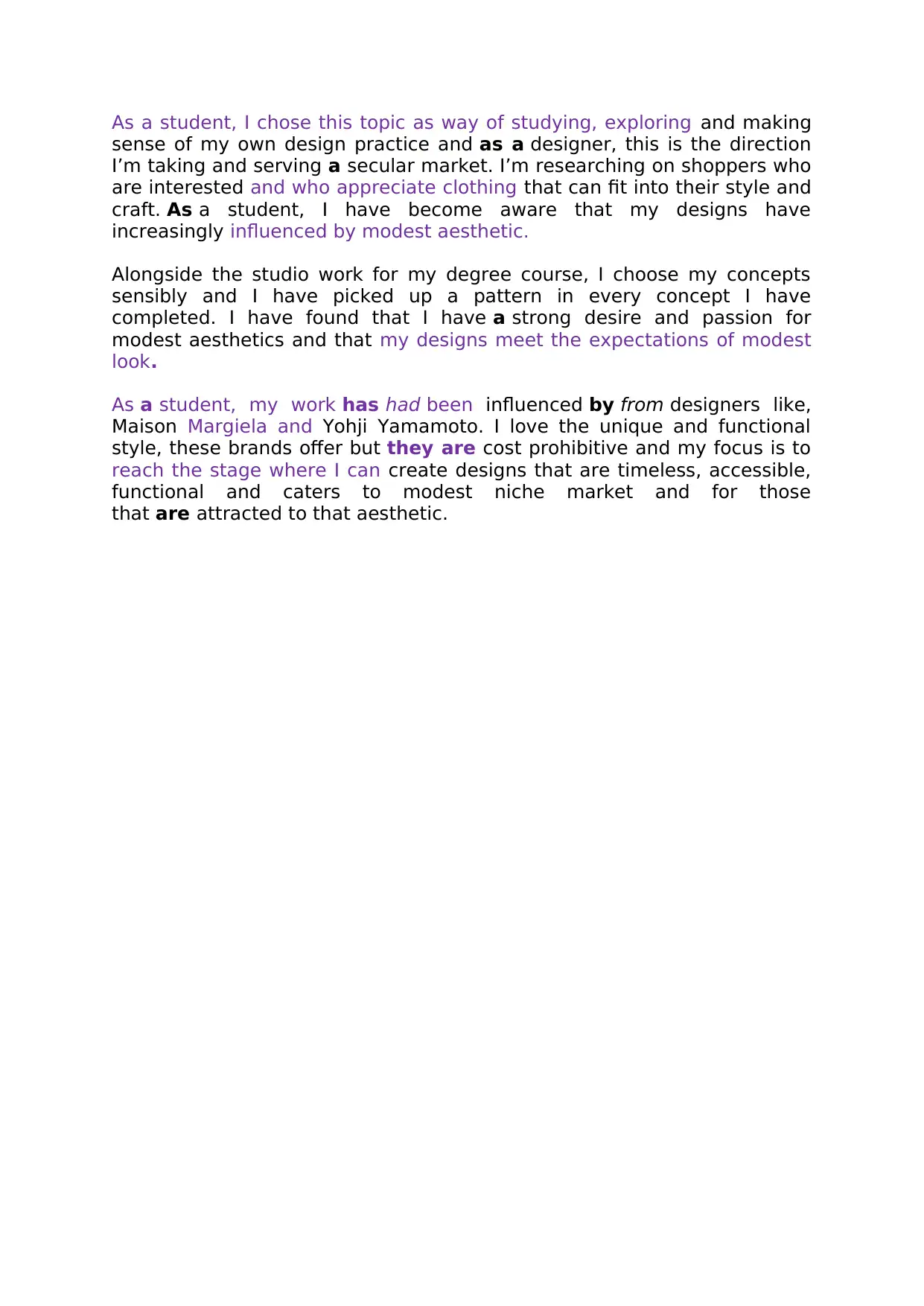
As a student, I chose this topic as way of studying, exploring and making
sense of my own design practice and as a designer, this is the direction
I’m taking and serving a secular market. I’m researching on shoppers who
are interested and who appreciate clothing that can fit into their style and
craft. As a student, I have become aware that my designs have
increasingly influenced by modest aesthetic.
Alongside the studio work for my degree course, I choose my concepts
sensibly and I have picked up a pattern in every concept I have
completed. I have found that I have a strong desire and passion for
modest aesthetics and that my designs meet the expectations of modest
look.
As a student, my work has had been influenced by from designers like,
Maison Margiela and Yohji Yamamoto. I love the unique and functional
style, these brands offer but they are cost prohibitive and my focus is to
reach the stage where I can create designs that are timeless, accessible,
functional and caters to modest niche market and for those
that are attracted to that aesthetic.
sense of my own design practice and as a designer, this is the direction
I’m taking and serving a secular market. I’m researching on shoppers who
are interested and who appreciate clothing that can fit into their style and
craft. As a student, I have become aware that my designs have
increasingly influenced by modest aesthetic.
Alongside the studio work for my degree course, I choose my concepts
sensibly and I have picked up a pattern in every concept I have
completed. I have found that I have a strong desire and passion for
modest aesthetics and that my designs meet the expectations of modest
look.
As a student, my work has had been influenced by from designers like,
Maison Margiela and Yohji Yamamoto. I love the unique and functional
style, these brands offer but they are cost prohibitive and my focus is to
reach the stage where I can create designs that are timeless, accessible,
functional and caters to modest niche market and for those
that are attracted to that aesthetic.
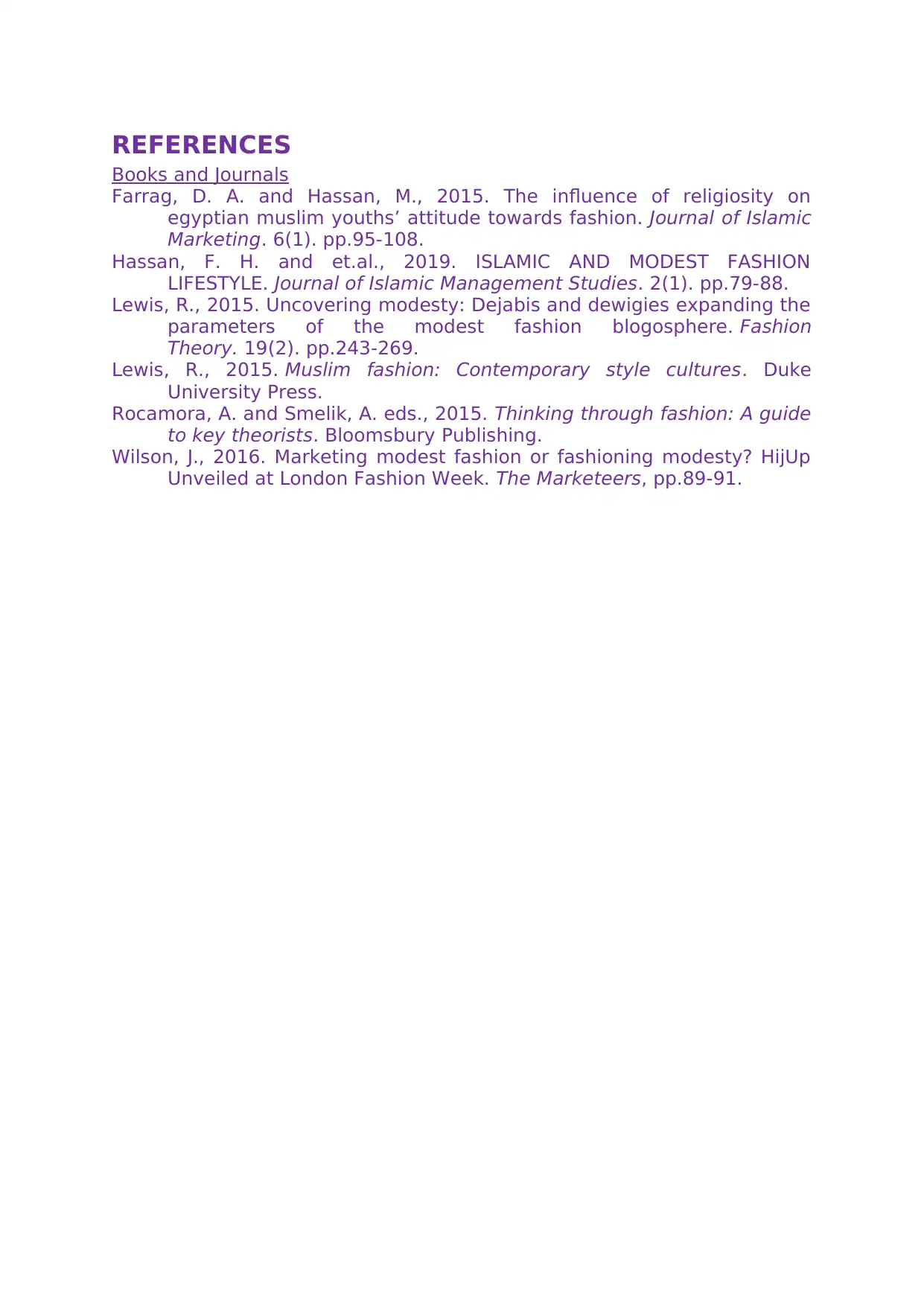
REFERENCES
Books and Journals
Farrag, D. A. and Hassan, M., 2015. The influence of religiosity on
egyptian muslim youths’ attitude towards fashion. Journal of Islamic
Marketing. 6(1). pp.95-108.
Hassan, F. H. and et.al., 2019. ISLAMIC AND MODEST FASHION
LIFESTYLE. Journal of Islamic Management Studies. 2(1). pp.79-88.
Lewis, R., 2015. Uncovering modesty: Dejabis and dewigies expanding the
parameters of the modest fashion blogosphere. Fashion
Theory. 19(2). pp.243-269.
Lewis, R., 2015. Muslim fashion: Contemporary style cultures. Duke
University Press.
Rocamora, A. and Smelik, A. eds., 2015. Thinking through fashion: A guide
to key theorists. Bloomsbury Publishing.
Wilson, J., 2016. Marketing modest fashion or fashioning modesty? HijUp
Unveiled at London Fashion Week. The Marketeers, pp.89-91.
Books and Journals
Farrag, D. A. and Hassan, M., 2015. The influence of religiosity on
egyptian muslim youths’ attitude towards fashion. Journal of Islamic
Marketing. 6(1). pp.95-108.
Hassan, F. H. and et.al., 2019. ISLAMIC AND MODEST FASHION
LIFESTYLE. Journal of Islamic Management Studies. 2(1). pp.79-88.
Lewis, R., 2015. Uncovering modesty: Dejabis and dewigies expanding the
parameters of the modest fashion blogosphere. Fashion
Theory. 19(2). pp.243-269.
Lewis, R., 2015. Muslim fashion: Contemporary style cultures. Duke
University Press.
Rocamora, A. and Smelik, A. eds., 2015. Thinking through fashion: A guide
to key theorists. Bloomsbury Publishing.
Wilson, J., 2016. Marketing modest fashion or fashioning modesty? HijUp
Unveiled at London Fashion Week. The Marketeers, pp.89-91.
⊘ This is a preview!⊘
Do you want full access?
Subscribe today to unlock all pages.

Trusted by 1+ million students worldwide
1 out of 6
Your All-in-One AI-Powered Toolkit for Academic Success.
+13062052269
info@desklib.com
Available 24*7 on WhatsApp / Email
![[object Object]](/_next/static/media/star-bottom.7253800d.svg)
Unlock your academic potential
Copyright © 2020–2025 A2Z Services. All Rights Reserved. Developed and managed by ZUCOL.